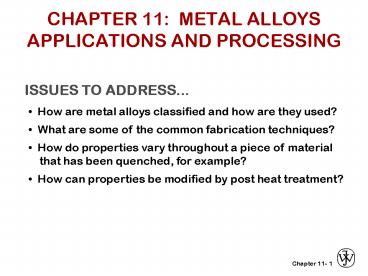CHAPTER 11: METAL ALLOYS APPLICATIONS AND PROCESSING - PowerPoint PPT Presentation
1 / 21
Title:
CHAPTER 11: METAL ALLOYS APPLICATIONS AND PROCESSING
Description:
How do properties vary throughout a piece of material. that has been ... How can properties be modified by post heat treatment? CHAPTER 11: METAL ALLOYS ... – PowerPoint PPT presentation
Number of Views:538
Avg rating:3.0/5.0
Title: CHAPTER 11: METAL ALLOYS APPLICATIONS AND PROCESSING
1
CHAPTER 11 METAL ALLOYSAPPLICATIONS AND
PROCESSING
ISSUES TO ADDRESS...
How are metal alloys classified and how are
they used?
What are some of the common fabrication
techniques?
How do properties vary throughout a piece of
material that has been quenched, for example?
How can properties be modified by post heat
treatment?
1
2
TAXONOMY OF METALS
Adapted from Fig. 11.1, Callister 6e.
Adapted from Fig. 9.21,Callister 6e. (Fig. 9.21
adapted from Binary Alloy Phase Diagrams, 2nd
ed., Vol. 1, T.B. Massalski (Ed.-in-Chief), ASM
International, Materials Park, OH, 1990.)
2
3
STEELS
Based on data provided in Tables 11.1(b),
11.2(b), 11.3, and 11.4, Callister 6e.
3
4
NONFERROUS ALLOYS
Based on discussion and data provided in Section
11.3, Callister 6e.
4
5
REFINEMENT OF STEEL FROM ORE
5
6
METAL FABRICATION METHODS-I
FORMING
Forging (wrenches, crankshafts)
Rolling (I-beams, rails)
often at elev. T
Adapted from Fig. 11.7, Callister 6e.
Drawing (rods, wire, tubing)
Extrusion (rods, tubing)
6
7
FORMING TEMPERATURE
Hot working --recrystallization
--less energy to deform --oxidation poor
finish --lower strength
Cold working --more energy to deform
--oxidation good finish --higher strength
Cold worked microstructures --generally are
very anisotropic!
--Forged
--Fracture resistant!
--Swaged
(a)
(b)
(c)
Reprinted w/ permission from R.W. Hertzberg,
"Deformation and Fracture Mechanics of
Engineering Materials", (4th ed.), John Wiley and
Sons, Inc., 1996. (a) Fig. 10.5, p. 410
(micrograph courtesy of G. Vander Voort, Car Tech
Corp.) (b) Fig. 10.6(b), p. 411 (Orig. source
J.F. Peck and D.A. Thomas, Trans. Metall. Soc.
AIME, 1961, p. 1240) (c) Fig. 10.10, p. 415
(Orig. source A.J. McEvily, Jr. and R.H. Bush,
Trans. ASM 55, 1962, p. 654.)
7
8
METAL FABRICATION METHODS-II
CASTING
Sand Casting (large parts, e.g.,
auto engine blocks)
Die Casting (high volume, low T alloys)
Continuous Casting (simple slab shapes)
Investment Casting (low volume, complex
shapes e.g., jewelry, turbine blades)
plaster die formed around wax prototype
8
9
METAL FABRICATION METHODS-III
JOINING
Powder Processing (materials w/low
ductility)
Welding (when one large part is
impractical)
Adapted from Fig. 11.8, Callister 6e. (Fig. 11.8
from Iron Castings Handbook, C.F. Walton and T.J.
Opar (Ed.), 1981.)
Heat affected zone (region in which the
microstructure has been changed).
9
10
THERMAL PROCESSING OF METALS
Annealing Heat to Tanneal, then cool slowly.
Based on discussion in Section 11.7, Callister 6e.
10
11
HARDENABILITY--STEELS
Ability to form martensite Jominy end
quench test to measure hardenability.
Adapted from Fig. 11.10, Callister 6e. (Fig.
11.10 adapted from A.G. Guy, Essentials of
Materials Science, McGraw-Hill Book Company, New
York, 1978.)
Hardness versus distance from the quenched end.
Adapted from Fig. 11.11, Callister 6e.
11
12
WHY HARDNESS CHANGES W/POSITION
The cooling rate varies with position.
Adapted from Fig. 11.12, Callister 6e. (Fig.
11.12 adapted from H. Boyer (Ed.) Atlas of
Isothermal Transformation and Cooling
Transformation Diagrams, American Society for
Metals, 1977, p. 376.)
12
13
HARDENABILITY VS ALLOY CONTENT
Jominy end quench results, C 0.4wtC
Adapted from Fig. 11.13, Callister 6e. (Fig.
11.13 adapted from figure furnished courtesy
Republic Steel Corporation.)
"Alloy Steels" (4140, 4340, 5140, 8640)
--contain Ni, Cr, Mo (0.2 to 2wt)
--these elements shift the "nose".
--martensite is easier to form.
13
14
QUENCHING MEDIUM GEOMETRY
Effect of quenching medium
Medium air oil water
Hardness small moderate large
Severity of Quench small moderate large
Effect of geometry When surface-to-volume
ratio increases --cooling rate
increases --hardness increases
Position center surface
Cooling rate small large
Hardness small large
14
15
PREDICTING HARDNESS PROFILES
Ex Round bar, 1040 steel, water quenched, 2"
diam.
Adapted from Fig. 11.18, Callister 6e.
15
16
PRECIPITATION HARDENING
Particles impede dislocations. Ex Al-Cu
system Procedure --Pt A solution heat
treat (get a solid solution) --Pt B
quench to room temp. --Pt C reheat to
nucleate small q crystals within a
crystals. Other precipitation systems
Cu-Be Cu-Sn Mg-Al
Adapted from Fig. 11.22, Callister 6e. (Fig.
11.22 adapted from J.L. Murray, International
Metals Review 30, p.5, 1985.)
Adapted from Fig. 11.20, Callister 6e.
16
17
PRECIPITATE EFFECT ON TS, EL
2014 Al Alloy
TS peaks with precipitation time.
Increasing T accelerates process.
EL reaches minimum with precipitation time.
Adapted from Fig. 11.25 (a) and (b), Callister
6e. (Fig. 11.25 adapted from Metals Handbook
Properties and Selection Nonferrous Alloys and
Pure Metals, Vol. 2, 9th ed., H. Baker (Managing
Ed.), American Society for Metals, 1979. p. 41.)
17
18
SIMULATION DISLOCATION MOTION PEAK AGED MATERIAL
Peak-aged --avg. particle size 64b
--closer spaced particles efficiently stop
dislocations.
Simulation courtesy of Volker Mohles, Institut
für Materialphysik der Universitåt, Münster,
Germany (http//www. uni-munster.de/physik /MP/moh
les/). Used with permission.
18
19
SIMULATION DISLOCATION MOTIONOVERAGED MATERIAL
Over-aged --avg. particle size 361b
--more widely spaced particles not as
effective.
Simulation courtesy of Volker Mohles, Institut
für Materialphysik der Universitåt, Münster,
Germany (http//www. uni-munster.de/physik /MP/moh
les/). Used with permission.
19
20
SUMMARY
Steels increase TS, Hardness (and cost) by
adding --C (low alloy steels) --Cr, V,
Ni, Mo, W (high alloy steels) --ductility
usually decreases w/additions. Non-ferrous
--Cu, Al, Ti, Mg, Refractory, and noble
metals. Fabrication techniques
--forming, casting, joining. Hardenability
--increases with alloy content. Precipitation
hardening --effective means to increase
strength in Al, Cu, and Mg alloys.
20
21
ANNOUNCEMENTS
Reading
Core Problems
Self-help Problems
0

